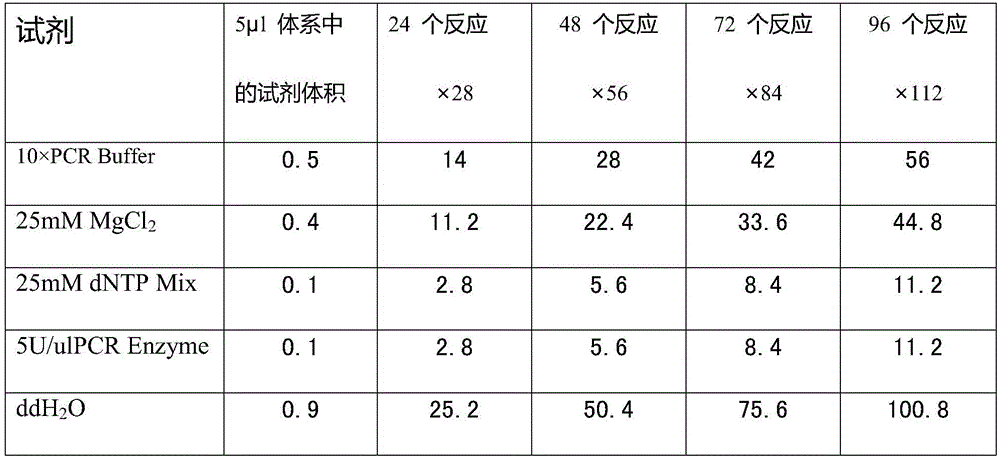Kit for detecting susceptibility of cervical cancer, and SNP marker of kit
A marker and susceptibility technology, applied in the field of genetic testing, can solve problems such as lack of system integration, limited detection range, and limitations, and achieve the effects of good technical reproducibility, high cost performance, and high practicability
- Summary
- Abstract
- Description
- Claims
- Application Information
AI Technical Summary
Problems solved by technology
Method used
Image
Examples
Embodiment 1
[0035] Example 1 Used to detect SNP sites related to cervical cancer susceptibility
[0036] Among them, rs16945692, rs7213430 and rs4968451 are located in the BRIP1 region of the gene, rs9344 is located in the CCND1 region of the gene, rs79190729 is located in the CD28 region of the gene, rs1801270 is located in the CDKN1A region of the gene, rs16997517 is located in the CSF2RB region of the gene, rs1126497 is located in the EPCAM region of the gene, rs1047840 is located in the 171 region of the gene EXO Gene EXOC1 region, rs3212227 in the gene IL12B region, rs2275913 in the gene IL17 region, rs1801275 in the gene IL4R region, rs28493229 in the gene ITPKC region, rs2736098 in the gene TERT region, rs16970849 in the gene TMC8 region, rs1799724 in the gene TNFα region, rs22909RC07 in the gene TN region region, rs8067378 is located in the gene ZPBP2 region.
Embodiment 2
[0037] Example 2 Kit for detecting susceptibility to cervical cancer
[0038] 1. Preparation of the kit:
[0039] 1. Design and synthesize PCR amplification primers and single-base extension primers for the 19 SNP sites. The PCR amplification primers and single base extension primers of the SNP sites to be tested are shown in Table 1
[0040] Table 1 PCR amplification primers and single-base extension primers for SNP sites to be tested
[0041]
[0042]
[0043] 2. The kit also includes Taq enzyme, dNTP mixture, MgCl 2 Solution, PCR reaction buffer, enzyme digestion reaction buffer, deionized water.
[0044] 2. The detection method of the kit:
[0045] 1. Extraction of DNA
[0046] 1.1 DNA extraction from oral swab
[0047] 1) Put the oral swab in a 2ml centrifuge tube and add 400μl PBS.
[0048] 2) Add 20 μl QIAGEN Protease and 400 μl Buffer AL. Immediately vortex for 15s to mix. To ensure efficient lysis, sample and Buffer AL must be mixed immediately and thor...
Embodiment 3
[0094] Example 3 Literature cited by 19 SNP sites closely related to cervical cancer
[0095] Table 5 Literature cited by 19 SNP sites closely related to cervical cancer
[0096]
[0097]
[0098]
PUM
 Login to View More
Login to View More Abstract
Description
Claims
Application Information
 Login to View More
Login to View More - R&D Engineer
- R&D Manager
- IP Professional
- Industry Leading Data Capabilities
- Powerful AI technology
- Patent DNA Extraction
Browse by: Latest US Patents, China's latest patents, Technical Efficacy Thesaurus, Application Domain, Technology Topic, Popular Technical Reports.
© 2024 PatSnap. All rights reserved.Legal|Privacy policy|Modern Slavery Act Transparency Statement|Sitemap|About US| Contact US: help@patsnap.com










